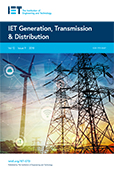|
Authors
Bakkar, Mostafa; Bogarra, Santiago; Rolán, Alejandro ; Córcoles, Felipe; Saura, Jaume ; Córcoles, Felipe; Saura, Jaume
|
Abstract
To ensure the safe operation of the grid, there are some requirements to be taken into consideration to connect power converters. During abnormal conditions – e.g. during voltage sags –, the control of the converters is a very important key to guarantee power quality and good behaviour of the distributed generation system. The aim of this study is to employ two possible control strategies for a grid-connected inverter according to the Spanish grid code, and to analyse the behaviour of the output voltages during both symmetrical and unsymmetrical voltage sags. The analytical development shows the sag influence on currents, voltages, active and reactive powers. These influences are explained through Ku transformation in the synchronous reference frame, thus giving a representation for electrical variables easiest to analyse. The results show how control strategies affect the converter behaviour and how they can support the main grid during faults through the control of active and reactive power injection. Sags with different durations and depths have been taken into account, which can provoke critical values for electrical magnitudes and can lead to the violation of the grid code. The proposed control strategies study has been validated by means of both simulations in M ATLAB TM–Simulink and experimental results.
|

WoS
Scopus
Altmetrics
  
|
|
Journal
IET Generation Transmission & Distribution, 22 May 2020, v.14, n.10,p.1882-1892
|
